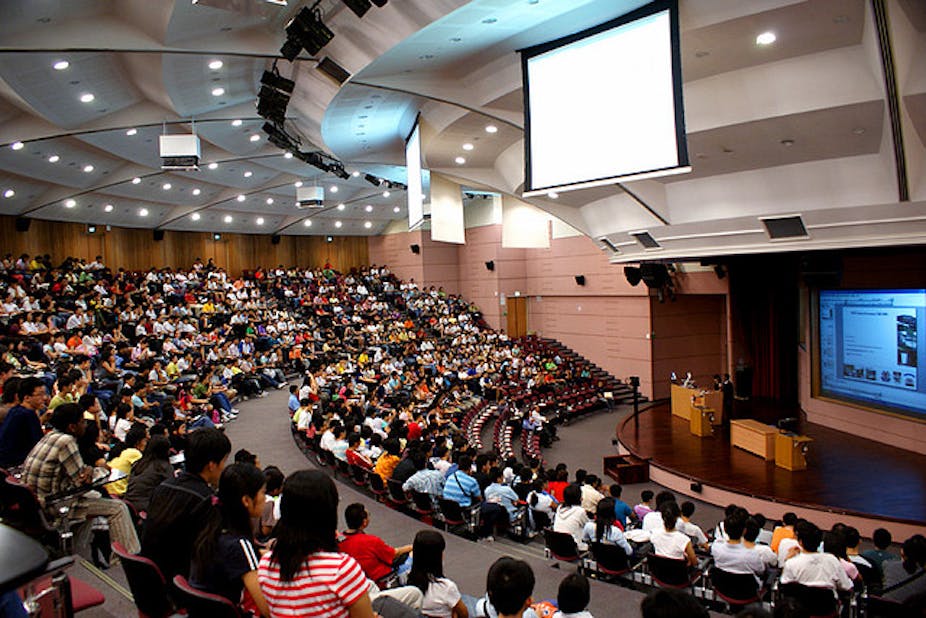Since the removal of caps on how many people can attend university came into effect, enrolments at Australian universities have grown by close to 40%. Earlier this year the Group of Eight elite universities highlighted a concern that the policy has negative impacts on student success – as measured by pass rates.
Comparing the latest pass rate figures reveals some significant areas of change:
In 2008 the lowest pass rate at a university was 79%. By 2013 this had decreased to 70%. The highest pass rate remained relatively constant at around 93%.
-
In 2008 only five universities had a pass rate of less than 80% (and all these were between 79% and 80%). By 2013 this figure had increased almost threefold to 13 universities (with a range now starting from 70%). At the other end, the five universities that had a pass rate of over 90% in 2008 had reduced to three by 2013.
The biggest drop by a single university over this time was a 12% decrease in pass rate. The biggest rise in comparison was 2.5%.
Students from low socio-economic backgrounds and with lower ATAR results were particularly affected.
Why are pass rates falling?
The decline in pass rates has not fallen equally across universities. The trend has been concentrated in the universities that have traditionally had lower pass rates. The universities with traditionally high pass rates have sustained these.
In 2008 the average for the half of universities with the highest pass rates was 88%, while the average for the half with the lower pass rate was 82%. By 2013, with uncapped funding in full swing, the universities with the higher pass rates had maintained a relatively similar rate, dropping by only 2% to 86%. For universities with the lower pass rates there was double the drop to 78%.
Such disparities point to a higher education system struggling to meet the potentially profound changes associated with widening participation and uncapped funding.
The disparity may in part have to do with how universities have responded to such changes - how they have managed growth and where this growth has come from. It appears the universities that have chosen massive online growth as a response to uncapped funding and widening participation have experienced detrimental effects on pass rates.
The highest decrease in pass rates of all Australian universities over the period was at Swinburne University, a university that undertook such a strategy. It attracted a large number of mature-age students and many students from low-socioeconomic and regional backgrounds. Two other universities with a similar focus on online enrolment, the University of New England and Central Queensland University, feature in the bottom five pass rates.
In the competitive context of uncapped funding, the universities with lower pass rates may increasingly be accepting more students with lower ATARs and from diverse and disparate backgrounds. These are students whose lives may be affected by difficult and demanding personal, work, financial, domestic and educational factors that “non-traditional” students are more likely to encounter.
The universities with lower pass rates have the greatest growth on average in low socio-economic students as a proportion of total growth in numbers since 2008 - 21% versus 13% for the higher pass rate universities. In terms of differences in ATAR, the average ATAR cut-off for the universities with higher pass rates is 75 while that for the universities with lower pass rates is 62 (based on averages of three course areas).
It is critical to point out that it is quite possible for universities to have high pass rates in increasing contexts of diversity. Not all universities with significant numbers of students from low socio-economic backgrounds show low pass rates or have low ATAR cut-offs.
The Universities of Newcastle, South Australia and Wollongong are in the half of universities with the highest pass rates and yet have one of the highest proportions of and growth in low socio-economic students. Similarly, the Australian Catholic University and La Trobe University have higher pass rates than average despite the fact that their ATAR cut-offs are, on average, among the lowest across the sector.
What can universities do?
The challenge for policy makers and universities is how to create environments that foster student success. This can’t be achieved by tinkering at the edges or by uncontained growth. It requires fundamental transformation.
The recently announced funding of Higher Education sub-degree programs offers opportunities to enable transition from diverse educational backgrounds to university study.
Also, rather than having a traditional first year which is a bit like being thrown in the deep end, degrees could be developed with a supportive foundation year focused on developing and building on students’ strengths. One of the universities that bucks the trend - La Trobe - has undertaken such a strategy. It is the one university that has moved from the bottom half to the top 10 pass rates over the period.
There are opportunities for schools, private providers, TAFEs and universities to work together to enable pathways for students from a range of backgrounds as is clearly required. Universities will need to re-imagine themselves and their approach to enable the student success needed.

